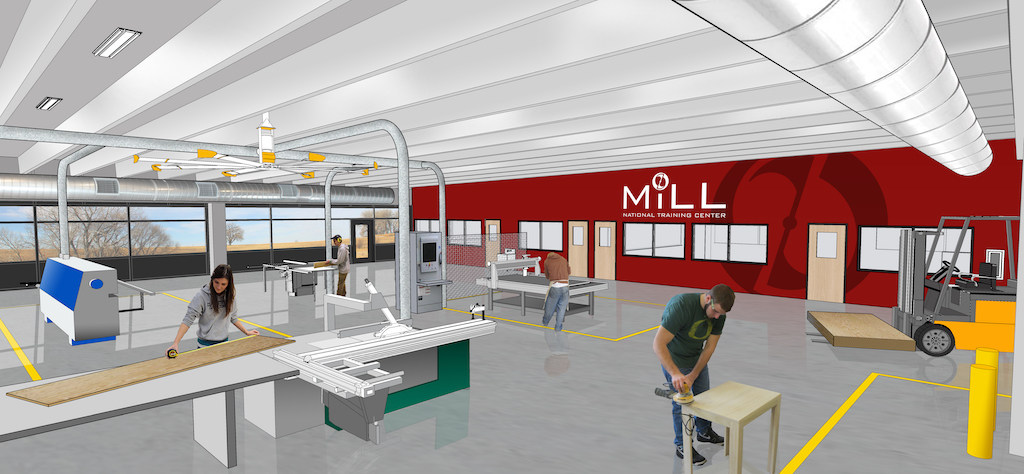By Sue Rose
The MILL National Training Center opened this month in a 46,600-square-foot factory renovated by RTA Architects near the Colorado Springs Airport. This first-of- its-kind training center is preparing high school students, college students, active military, and Wounded Warriors for lucrative careers in the skilled trades. There are also programs for industrial arts teachers and administrators to bring professional, industry-oriented programs to their classrooms and for those already in the industry to further their skills. Located near Shriver Air Force Base, the MILL (Manufacturing Industry Learning Lab), is the result of the unique collaboration among the Peyton and Widefield R-3 school districts, private funding, and industry collaboration and donations.
The MILL rose from the empty shell of a 45,000-square-foot potato chip factory in southern Colorado. Transformed by RTA Architects, this facility promises to be the model for manufacturing and construction training across the globe. As part of the project, RTA Architects was given an exciting opportunity to work with the Peyton and Widefield School Districts to assist in program marketing and branding efforts. Through a collaborative group-think session,
RTA and school district representatives established the MILL – National Training Center brand and associated logo. The creation of the MILL is in direct response to the current lack of skilled tradesmen and women that has been decades in the making.
Bringing Back Technical Trade Education
School districts throughout Colorado are re-emphasizing education and training in technical trades for students with talents and interests that don’t match or require the traditional four-year-degree model. The trend to offer hands-on maker spaces that mushroomed after the 2005 launch of Make: Magazine proved that collaboration and hand-on tinkering is fulfilling and educational. At the early stages of the trend, most maker spaces focused on circuitry, robotics, and the like. However a deep yearning for hands-on learning has stretched across disciplines, and educators now know that pushing every student into a college track isn’t always fruitful.
Today’s construction boom has exacerbated this problem, creating an extreme need for skilled laborers in the building trades across Colorado and the country. The Bureau of Labor Statistics Job Openings and Labor Turnover Survey (JOLTS) show that nearly 200,000 construction industry jobs are unfilled across the country at a boom time for homebuilders, a jump of 81 percent in just two years. At 4.5 percent, unemployment in the U.S. construction industry is the lowest in a decade, putting increased pressure on foremen, project managers, and developers. The market has also suffered a death of cabinet-makers, welders, electricians, mechanics, advanced manufacturing, and other skilled trade professionals not produced by traditional colleges and universities.
Woods Manufacturing
The MILL woods manufacturing program is providing high school students access to state-of-the-art computer numerical controlled (CNC) woods manufacturing equipment. RTA worked very closely with the MILL staff to understand the specialized requirements of these machines so that spaces would accommodate not only the computer and technical equipment, but also support the programming and control of these machines. Multiple layouts were developed, studied and reviewed with CNC instructors to find the ideal layout and function of these support spaces.
Through intentional exploration, RTA gained understanding of the woods manufacturing process, workflow, and materials processing to provide an equipment layout that facilitates a smooth efficient flow of raw material into finished product. The program strives to create an atmosphere that prepares students for what they will experience in the manufacturing industry after they have entered the workforce.
Construction Trades
The construction trades program includes specialized classrooms and defined workspaces that support an open work area concept. The flexible open work area is designed to accommodate construction projects of varying sizes within the building. Separate project work areas provide collaborative spaces and class separation when desired. The design also provides for specialized equipment and storage.
Shared Use Spaces
The MILL’s vision is that the construction trades program and the woods manufacturing program will engage and support one another. Shared spaces are programmed to enhance this connection, including a shared student entry/lounge space, a common shipping/receiving and storage area, and a shared administration area. At the heart of the facility is a large open conference space. The conference space will be used not only by students and staff, but also by corporate and industry partners to display products and equipment. To foster partnerships with manufacturing and construction industries, the flexibility of this space will allow large conferences as well as the display of material, equipment, and tools.
“RTA’s ability to design our facilities has been a total turnkey success for us,” noted MILL Founder and President Dean Mattson. “In addition, they have a vision for architecture that includes leading edge CNC training for members of their staff that, as partners, will participate in this training. This enhances the MILL’s reputation as having the ability to respond quickly to the needs of our industry partners, which in turn helps our students.”
While the MILL may be finished, RTA’s partnership with the MILL will continue. The architects will give guest lectures and provide feedback on the students’ craftsmanship. The ultimate goal will be to influence the students’ thinking about how this state-of- the-art machinery impacts not only the students’ end products, but also how the woods manufacturing process can be used to influence and inform architectural design.
“Because of RTA’s expanding maker culture and our commitment to life-long learning, there is an exciting opportunity to create a research and development relationship with the students and staff at the MILL to experiment with and mock up architectural elements, finishes, and connections. We’ll share our expertise and knowledge with them and they’ll share their manufacturing skills with us. We’re thrilled to be working with the MILL and can’t wait to see where it leads all of us,” says Ken Gregg, RTA Associate and Project Architect.
Rendering courtesy of RTA Architects.









